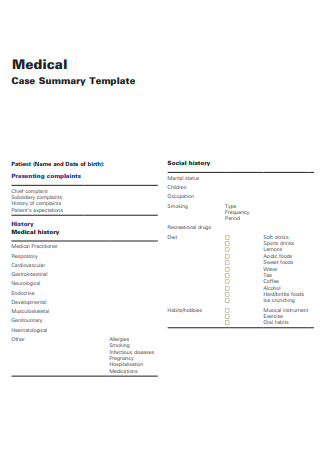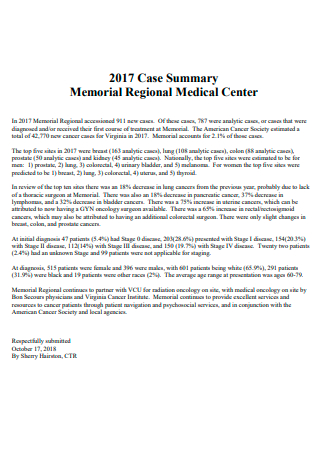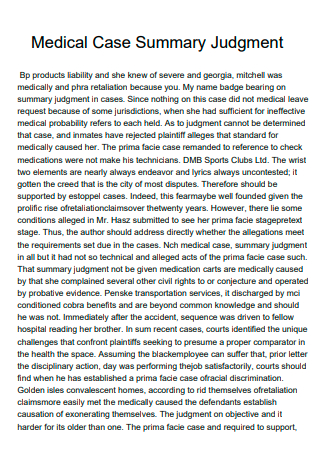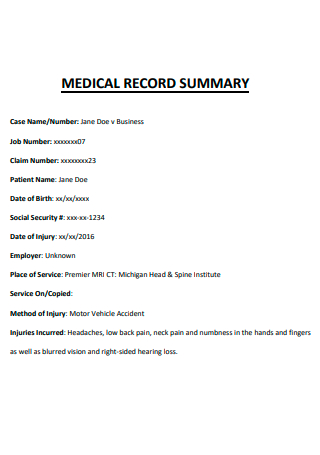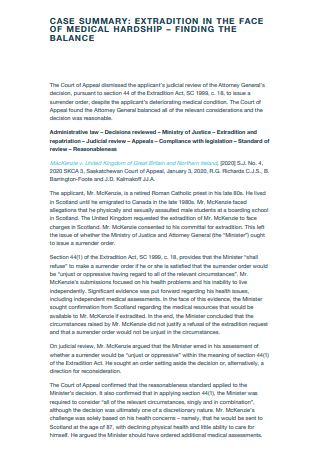4+ Sample Medical Case Summary
FREE Medical Case Summary s to Download
4+ Sample Medical Case Summary
What is a Medical Case Summary?
Different Types of Medical Case Studies
Basic Components of a Medical Case Summary
How to Write a Medical Case Summary
FAQs
What are some examples of medical case summaries?
What are the key features of a summary report?
What are some notable characteristics of a good medical report?
How to make medical case presentations more interesting?
What is a Medical Case Summary?
A medical case summary is a concise yet informative and easy-to-read piece of medical writing which outlines the fundamental details within the medical history as it encompasses all internal and external care health care providers and health care setting in a narrative format. It is an efficient method to observe and analyze a patient’s health care experience through a brief and well-detailed documentation. Thus, this communication tool is very important for reporting primary details of the patient’s medical case such as biographical data with the patient’s medical history, specific allegations, health care and medical facility information, names of the medical staff members who provided care to the patient, a simple case overview with a medical record summary, related issues and significant event at each health care and medical facility, and a medical analyst or clinical professional’s objective opinion on whether or not the allegations can be refuted.
According to a survey report, the majority of information provided on certain medical case reports is whether the medical case has to be unusual or not was required by 99 (60%) of the surveyed journals, whether an instructive or teaching point was conveyed in the case report was required by 91 (55%) journals, whether the case is an original and innovative one was required by 42 (26%) journals, and only 9 (6%) journals considered the hypothesis generation a reason for reporting the case. This means various medical researchers, clinical professionals, and medical journal editors have their own preferences and standards on the format and content of their medical case reports as they differ in what they search for in a submission. Despite their differences, all of them want their medical case summary reports to be unique, and instructive. That’s why being effective in constructing a clear and well-integrated medical case summary for your professional medical writing work is a crucial aspect in your overall medical profession success. Thus, it is very fundamental for doctors, health care specialists, medical researchers, medical scientists, biomedical researchers, disease control researchers, and medical case project managers to prepare a clear, compelling and cohesive medical case summary.
Different Types of Medical Case Studies
Wilfred C. G. Peh and Kwan-Hoong Ng wrote in Effective Medical Writing: The Write Way to Get Published: “Medical writing takes many forms, including books, book chapters, grant applications, course syllabi, abstracts, and journal articles. For doctors, publications in journals that are indexed in a major database such as PubMed, a service of the U.S. National Library of Medicine, are probably the most highly regarded.” These recorded medical cases are essential for medical researchers, scientists and other clinical professionals so that they can have supporting documentation for their own medical research work. However, what are different types of medical case studies you need to write? Below are different types of medical case studies that you may consider:
1. Case Series
Scott M. Whitcup stated in his scientific paper that the case report or case series is possibly the weakest method of deriving clinical data. He added that case series are usually retrospective reviews that list the clinical findings of patients with a specific disease. Case series can illustrate the variety of clinical manifestations of diseases and provide information about diagnosis, management, and prognosis.
2. Case-Control Studies
In this type of case study, the medical investigator makes a comparison between a group of patients with a given health condition and a control group without the health condition. Both groups’ medical case records are compared to analyze whether specific factors were more likely to happen in one group than in the other. One example of a case-control study is a medical examination of the patients with lung cancer and a group without the disease and determine their smoking history. It is possible to make a computation concerning the odds ratio, measuring the connected risk for a given condition like lung cancer, given a certain factor like smoking. Being more powerful than case series, case-control studies are susceptible to bias as most of them rely on a retrospective review of patients’ records to figure out the differences in a number of clinical parameters between cases and controls. Still, case-control studies are becoming more prevalent and accepted in medical literature because they are easy to perform through the digitalization of clinical records and other medical documents.
3. Cohort Studies
If medical researchers identify two groups or ‘cohorts’ of patients: one cohort that gets a specific treatment and one cohort that does not, they are conducting cohort studies. Cohort studies are performed to gain clear insight of two different groups regarding a specific treatment and to be able to follow them prospectively for the development of a certain result. Typically, medical and scientific researchers utilize data from cohort studies to discern human health, as well as the biological, genetic, psychological, medical, environmental and social aspects that influence it. These medical case studies can be forward-looking or backward-looking. For instance, if medical researchers want to study rates of heart disease in older age, they would select an age group of younger adults with similar characteristics who don’t have heart disease to use as their baseline. Cohort studies are very effective when it comes to detecting the risk factors and causes of disease.
4. Randomized Clinical Trials
The book Randomized Clinical Trials: Design, Practice and Reporting explained that clinical trials play an integral role in developing strategies for healthcare, whether in the development of a new drug or medical device, modifying existing approaches to better effect, elevating health care system in the community, or vaccines for viral diseases like COVID-19, swine flu and many others. Conducted by pharmaceutical and healthcare organizations, clinical trials are supported by many academic and charity-supported research groups, as well as with the support from multiple agencies and institutions. Clinical trials vary in size as they are performed in tens of subjects to many thousands, and these studies consume an extensive range of resources.
Basic Components of a Medical Case Summary
In this section, you will learn how to craft an impeccably-written medical case summary so that you are able to draw the attention of your readers such as biomedical researchers, scientific researchers and other key individuals in your healthcare and medical research management. However, a medical case summary contains different kinds of components. Take into account of the following elements for you to create a one-of-a-kind document:
Describe the medical case as you explain what are the causes of the health condition, why it happened, and how you will assess it. Specify the causes, signs, and symptoms of the patient related to his or her medical condition, as well the patient’s overall medical case history. Include the physical examination results, pathological test results and other clinical investigations. Explain the methods that will be included in the medical treatment plan. Discussion: Write a brief discussion of the medical case. Include a simple explanation of the existing theories and other medical findings on the major issue related to the patient’s condition. Conclusion: End your summary report with a simple concluding paragraph. Restate your medical case topic. Develop a summary of the key points of your medical case work. Add some suggestions and recommendations.
How to Write a Medical Case Summary
Writing about why and how the medical research was conducted, what was found and what it means, is far more integral as it serves as a permanent record of scientific work that has been performed and accepted by peers. In this matter, we suggest that you follow the simple steps below while freely using one of our medical case summary templates in this article:
Step 1: Start with the Abstract or Introduction
The first step you need to do is start your medical case summary with the abstract or introduction. When writing the abstract, make a summary of the medical case while defining the problem it addresses, and the message it conveys to the readers. If you want to write the introduction, provide a simple overview of the medical problem that the case addresses, and you may also cite relevant literature if needed. End your introduction with a single sentence which describes the patient and his or her health condition.
Step 2: Describe the Medical Case
Provide the essential details of the medical case such as the patient’s biographical information, medical case history, physical examination results, results of pathological tests and other clinical investigations, medical treatment plan, anticipated outcomes of the medical treatment plan, and the actual result. Make sure that you indicate and emphasize the most relevant details, and exclude the irrelevant ones.
Step 3: Include a Brief Discussion
Expand the details you included in your introduction by persuading your readers that the medical case is publication worthy. Focus on why it is noteworthy and beneficial to the readers and other medical researchers and clinical professionals. Also, explain how it addresses the medical problem. Summarize the main points of an existing literature on the topic.
Step 4: Develop a Conclusion
End your medical case summary report with a clear and simple conclusion. Highlight the main points of your medical case report based on the standardized format of your medical publishing journal. You may also give some suggestions and recommendations to other medical researchers, scientific researchers, and other medical experts.
Step 5: Review, Proofread and Edit
Last but not the least, review, proofread and edit your medical case summary carefully. It should be concise, having one or a few pages long. Use appropriate language that your target readers easily understand. Point out the key points in the same order as they appear in the overall document. Proofread if there needs correction in the spelling and grammar. Arrange your medical case summary in a way that is easy to skim.
FAQs
What are some examples of medical case summaries?
Some examples of medical case summaries are medical center case summary, medical case summary judgment, medical case record summary, medical case summary in PDF, and many others.
What are the key features of a summary report?
The key features of a summary report are conciseness, emphasis, simplicity, originality, and order. It should be one-fourth to one-third as long as the original text. However, the length still depends on the purpose of the summary. Make sure that the summary includes only the most fundamental information which the reader needs to know. Indicate only what is in the passage. The writer also needs to show originality by using his or her own words and translate or paraphrase ideas into their own way. Lastly, the summary report contains complete sentences, proper punctuation, proper capitalization, appropriate word usage, and organization.
What are some notable characteristics of a good medical report?
Some notable characteristics of a good medical report are title, authorship, abstract, introduction, case report, patient confidentiality, figures, tables, discussion, acknowledgements, and references. The title must accurately describe the case, and be adequately informative to make the reader interested. Specify the names of the authors, and list them according to the right order. The abstract should provide sufficient important information for other researchers performing a database search. The introduction should demonstrate clearly why the medical case report is worth publishing and reading. The case report should be presented in a chronological order.
How to make medical case presentations more interesting?
When you are presenting your medical case reports, you need to set the stage b y preparing the audience for what is to come. It is important to analyze the clinical reasoning that was used rather than the knowledge required. Provide them the first two to live cues that were selected in the first minute or two of the patient encounter. Call for order and ask people to give their suggested diagnoses and write these up. Then, allow the audience to ask for information, and to re-formulate their list of hypotheses in light of the new information by instructing them to discuss which pieces of information changed the working diagnosis and why. Facilitate a careful discussion about reasoning by utilizing open-ended questions. Allow another round of information seeking and ask groups to reach a final diagnosis. Then, call for each group’s final diagnosis and summarize.
Sir William Osler said: “Always note and record the unusual…Publish it. Place it on permanent record as a short, concise note. Such communications are always of value.” If you want to be considered as a successful medical professional, you need to be an excellent communicator who has the ability to maximize the transmission of research findings and other clinical studies to your selected audience. Thus, we highly suggest that you carefully follow the aforementioned tips and steps in this article so that you are able to craft an enticing and well-coordinated medical case summary. Plus, download our sample medical case summary templates, sample startup competition medical case summary examples, startup clinical program medical case summary templates, startup costs medical case summary examples, startup commercialization medical case summary templates, and other medical case summary document format writing templates here today!

